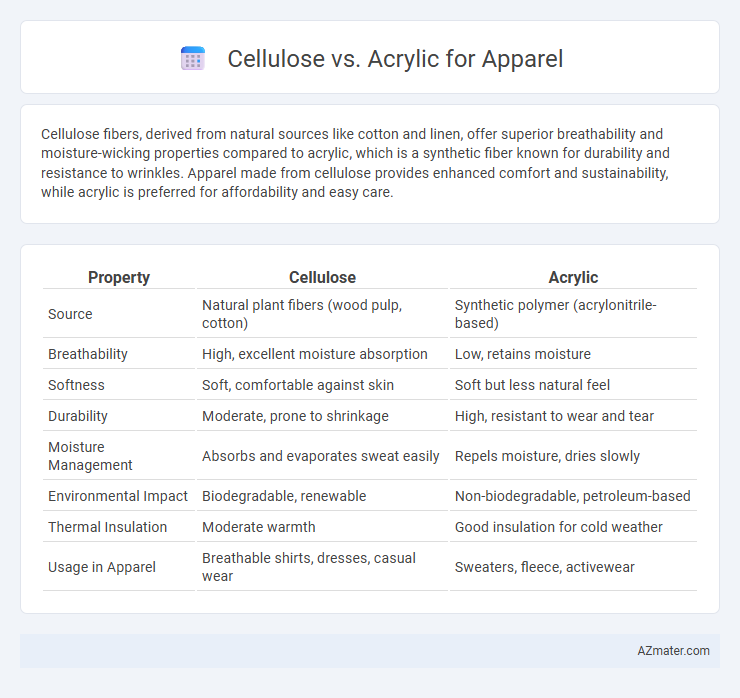Cellulose fibers, derived from natural sources like cotton and linen, offer superior breathability and moisture-wicking properties compared to acrylic, which is a synthetic fiber known for durability and resistance to wrinkles. Apparel made from cellulose provides enhanced comfort and sustainability, while acrylic is preferred for affordability and easy care.
Table of Comparison
| Property | Cellulose | Acrylic |
|---|---|---|
| Source | Natural plant fibers (wood pulp, cotton) | Synthetic polymer (acrylonitrile-based) |
| Breathability | High, excellent moisture absorption | Low, retains moisture |
| Softness | Soft, comfortable against skin | Soft but less natural feel |
| Durability | Moderate, prone to shrinkage | High, resistant to wear and tear |
| Moisture Management | Absorbs and evaporates sweat easily | Repels moisture, dries slowly |
| Environmental Impact | Biodegradable, renewable | Non-biodegradable, petroleum-based |
| Thermal Insulation | Moderate warmth | Good insulation for cold weather |
| Usage in Apparel | Breathable shirts, dresses, casual wear | Sweaters, fleece, activewear |
Introduction: Cellulose vs Acrylic in Apparel
Cellulose and acrylic fibers represent two distinct categories of textiles used in apparel, each with unique properties tailored to different needs. Cellulose fibers, derived from natural sources like cotton, rayon, and lyocell, offer breathability, moisture absorption, and biodegradability, making them ideal for comfortable, eco-friendly clothing. Acrylic fibers, synthetic polymers produced from acrylonitrile, provide durability, softness, and resistance to wrinkles and fading, suited for vibrant, long-lasting garments.
Material Origins: What Are Cellulose and Acrylic Fibers?
Cellulose fibers are natural fibers derived from plant sources such as cotton, wood pulp, and flax, making them biodegradable and eco-friendly. Acrylic fibers, on the other hand, are synthetic polymers made from polyacrylonitrile, a petroleum-based chemical, known for their durability and wool-like texture. Understanding the origins of these materials highlights cellulose as renewable and acrylic as petroleum-derived, influencing their environmental impact and fabric properties in apparel.
Production Process: How Cellulose and Acrylic Are Made
Cellulose fibers are produced from natural plant sources such as wood pulp through chemical processes like viscose or lyocell manufacturing, where cellulose is dissolved, purified, and regenerated into fibers. Acrylic fibers are synthesized from petrochemicals by polymerizing acrylonitrile monomers into long chains through a chemical process called polymerization, followed by extrusion into fibers. The production of cellulose fibers involves renewable raw materials and environmentally intensive chemical treatments, while acrylic relies on fossil fuel derivatives and energy-intensive polymerization methods.
Environmental Impact: Sustainability Comparison
Cellulose fibers, derived from natural sources like wood pulp and cotton, offer greater biodegradability and lower carbon footprints compared to synthetic acrylic fibers made from petroleum-based polymers. The production of cellulose involves renewable raw materials and often uses less energy and water, contributing to reduced environmental pollution and resource depletion. In contrast, acrylic fabrics generate significant greenhouse gas emissions and microplastic pollution, raising concerns about their long-term sustainability in apparel manufacturing.
Comfort and Feel: Softness, Breathability, and Texture
Cellulose fibers such as viscose and lyocell offer superior softness and breathability compared to acrylic, making them ideal for comfortable apparel that feels gentle against the skin. Acrylic fabrics tend to be less breathable and can sometimes feel rough or synthetic, which impacts overall wearability. The natural origin and moisture-wicking properties of cellulose fibers enhance comfort by maintaining dryness and a smooth texture throughout the day.
Durability: Longevity and Wear Resistance
Cellulose fibers such as cotton and viscose offer moderate durability with good breathability but tend to wear down faster and lose shape after repeated washing. Acrylic fibers provide superior longevity and wear resistance, maintaining color retention and elasticity over extensive use, making them ideal for long-lasting apparel. The synthetic nature of acrylic allows it to resist abrasion, stretching, and weathering more effectively than natural cellulose fibers.
Care and Maintenance Requirements
Cellulose fibers like cotton and modal require gentle washing with mild detergents and should be air-dried to prevent shrinkage and maintain fabric integrity. Acrylic fabrics are more resistant to wrinkles and shrinking, but they need low-heat drying and should be washed with cool water to avoid pilling and color fading. Proper care ensures longevity, with cellulose demanding delicate handling and acrylic benefiting from machine wash durability but with heat precautions.
Cost Analysis: Price Point Differences
Cellulose fibers, such as viscose and lyocell, generally offer a moderate price point due to their natural origin and sustainable processing methods, making them cost-effective for mid to high-end apparel markets. Acrylic fibers, derived from synthetic polymers, tend to be cheaper in raw material costs and mass production, positioning them as a budget-friendly option for affordable, fast-fashion garments. The choice between cellulose and acrylic significantly impacts overall fabric cost, with cellulose offering value in eco-conscious branding and acrylic excelling in low-cost production scales.
Popular Uses in Fashion and Apparel
Cellulose fibers such as cotton, rayon, and lyocell are widely favored in fashion for their breathability, moisture-wicking properties, and sustainable appeal, making them ideal for casual wear, dresses, and eco-conscious apparel lines. Acrylic fibers mimic the softness and warmth of wool, often used in sweaters, knitwear, and cozy outerwear for their lightweight insulation and vibrant color retention. Both fibers serve distinct purposes in apparel, with cellulose excelling in comfort and sustainability while acrylic specializes in durability and colorfastness.
Conclusion: Which Fabric Wins for Apparel?
Cellulose fibers like cotton and rayon offer superior breathability, moisture absorption, and natural comfort, making them ideal for everyday apparel with a soft hand feel and better biodegradability. Acrylic fibers provide durability, vibrant color retention, and resistance to wrinkles, making them popular for activewear and outerwear, but they lack the eco-friendly profile of cellulose. For apparel prioritizing sustainability and comfort, cellulose wins, whereas acrylic suits performance-focused garments.

Infographic: Cellulose vs Acrylic for Apparel
 azmater.com
azmater.com